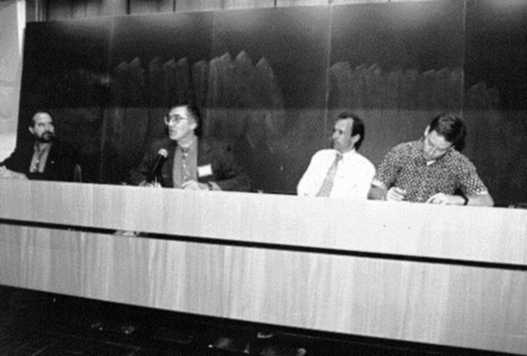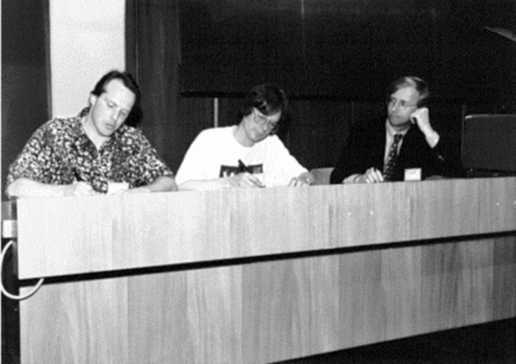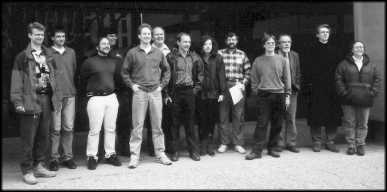It's very important language?Yes it is!.
How important HTML in the website progamming? THE ANSWER is very very IMPORTANT. Almost every website on around the world using HTML language as basic code.
There is litle history about HTML language.
1989: Tim Berners-Lee invents the Web with HTML as its publishing language
The World Wide Web began life in the place where you would least expect it: at CERN, the European Laboratory for Particle Physics in Geneva, Switzerland. CERN is a meeting place for physicists from all over the world, where highly abstract and conceptual thinkers engage in the contemplation of complex atomic phenomena that occur on a minuscule scale in time and space. This is a surprising place indeed for the beginnings of a technology which would, eventually, deliver everything from tourist information, online shopping and advertisements, financial data, weather forecasts and much more to your personal computer.
Tim's prototype Web browser on the NeXT computer came out in 1990.
Through 1990: The time was ripe for Tim's invention
The fact that the Web was invented in the early 1990s was no coincidence. Developments in communications technology during that time meant that, sooner or later, something like the Web was bound to happen. For a start, hypertext was coming into vogue and being used on computers. Also, Internet users were gaining in the number of users on the system: there was an increasing audience for distributed information. Last, but not least, the new domain name system had made it much easier to address a machine on the Internet
Hypertext
Although already established as a concept by academics as early as the 1940s, it was with the advent of the personal computer that hypertext came out of the cupboard. In the late 1980s, Bill Atkinson, an exceptionally gifted programmer working for Apple Computer Inc., came up with an application called Hypercard for the Macintosh. Hypercard enabled you to construct a series of on-screen `filing cards' that contained textual and graphical information. Users could navigate these by pressing on-screen buttons, taking themselves on a tour of the information in the process.
Hypercard and its imitators caught the popular imagination. However, these packages still had one major limitation: hypertext jumps could only be made to files on the same computer. Jumps made to computers on the other side of the world were still out of the question. Nobody yet had implemented a system involving hypertext links on a global scale.
The domain name system
By the middle 1980s, the Internet had a new, easy-to-use system for naming computers. This involved using the idea of the domain name. A domain name comprises a series of letters separated by dots, for example: `www.bo.com' or `www.erb.org.uk'. These names are the easy-to-use alternative to the much less manageable and cumbersome IP address numbers.
A program called Distributed Name Service (DNS) maps domain names onto IP addresses, keeping the IP addresses `hidden'. DNS was an absolute breakthrough in making the Internet accessible to those who were not computer nerds. As a result of its introduction, email addresses became simpler. Previous to DNS, email addresses had all sorts of hideous codes such as exclamation marks, percent signs and other extraneous information to specify the route to the other machine.
September 1991: Open discussion about HTML across the Internet begins
Here, in Tim's tiny room in the bowels of the sprawling buildings of CERN, the two engineers further considered how HTML might be taken from its current beginnings and shaped into something more appropriate for mass consumption. Trying to anticipate the kind of features that users really would like, Dave looked through magazines, newspapers and other printed media to get an idea of what sort of HTML features would be important when that same information was published online. Upon return to England, Dave sat down at his keyboard and resolutely composed HTML+, a richer version of the original HTML
Late 1992: NCSA is intrigued by the idea of the Web
Meanwhile on the other side of the world, Tim's ideas had caught the eye of Joseph Hardin and Dave Thompson, both of the National Center for Supercomputer Applications, a research institute at the University of Illinois at Champaign-Urbana. They managed to connect to the computer at CERN and download copies of two free Web browsers. Realizing the importance of what they saw, NCSA decided to develop a browser of their own to be called Mosaic. Among the programmers in the NCSA team were Marc Andreessen - who later made his millions by selling Web products - and the brilliant programmer Eric Bina - who also became rich, courtesy of the Web. Eric Bina was a kind of software genius who reputedly could stay up three nights in succession, typing in a reverie of hacking at his computer.
December 1992: Marc Andreessen makes a brief appearance on WWW- talk
Early Web enthusiasts exchanged ideas and gossip over an electronic discussion group called WWW-talk. This was where Dave Raggett, Tim Berners-Lee, Dan Connolly and others debated how images (photographs, diagrams, illustrations and so on) should be inserted into HTML documents. Not everyone agreed upon the way that the relevant tag should be implemented, or even what that tag should be called. Suddenly, Marc Andreessen appeared on WWW-talk and, without further to-do, introduced an idea for the IMG tag by the Mosaic team.
It was quite plain that the others were not altogether keen on the design of IMG, but Andreessen was not easily redirected. The IMG tag was implemented in the form suggested by the Mosaic team on its browser and remains to this day firmly implanted in HTML. This was much to the chagrin of supporters back in academia who invented several alternatives to IMG in the years to come. Now, with the coming of HTML 4, the OBJECT tag potentially replaces IMG, but this is, of course, some years later.
March 1993: Lou Montulli releases the Lynx browser version 2.0a
Lou Montulli was one of the first people to write a text-based browser, Lynx. The Lynx browser was a text-based browser for terminals and for computers that used DOS without Windows. Lou Montulli was later recruited to work with Netscape Communications Corp., but nonetheless remained partially loyal to the idea of developing HTML as an open standard, proving a real asset to the HTML working group and the HTML Editorial Board in years to come. Lou's enthusiasm for good, expensive wine, and his knowledge of excellent restaurants in the Silicon Valley area were to make the standardization of HTML a much more pleasurable process.
Early 1993: Dave Raggett begins to write his own browser
While Eric Bina and the NCSA Mosaic gang were hard at it hacking through the night, Dave Raggett of Hewlett-Packard Labs in Bristol was working part-time on his Arena browser, on which he hoped to demonstrate all sorts of newly invented features for HTML.
April 1993: The Mosaic browser is released
In April 1993, version 1 of the Mosaic browser was released for Sun Microsystems Inc.'s workstation, a computer used in software development running the UNIX operating system. Mosaic extended the features specified by Tim Berners-Lee; for example, it added images, nested lists and fill-out forms. Academics and software engineers later would argue that many of these extensions were very much ad hoc and not properly designed.
Late 1993: Large companies underestimate the importance of the Web
Dave Raggett's work on the Arena browser was slow because he had to develop much of it single-handedly: no money was available to pay for a team of developers. This was because Hewlett-Packard, in common with many other large computer companies, was quite unconvinced that the Internet would be a success; indeed, the need for a global hypertext system simply passed them by.
There was also a misconception that the Internet was mostly for academics. In some companies, senior management was assured that the telephone companies would provide the technology for global communications of this sort, anyway. The result was that individuals working in research labs in the commercial sector were unable to devote much time to Web development.
.
May 1994: NCSA assigns commercial rights for Mosaic browser to Spyglass, Inc.
In May 1994, Spyglass, Inc. signed a multi-million dollar licensing agreement with NCSA to distribute a commercially enhanced version of Mosaic. In August of that same year, the University of Illinois at Champaign-Urbana, the home of NCSA, assigned all future commercial rights for NCSA Mosaic to Spyglass.
May 1994: The first World Wide Web conference is held in Geneva, with HTML+ on show
Although Marc Andreessen and Jim Clark had commercial interests in mind, the rest of the World Wide Web community had quite a different attitude: they saw themselves as joint creators of a wonderful new technology, which certainly would benefit the world. They were jiggling with excitement. Even quiet and retiring academics became animated in discussion, and many seemed evangelical about their new-found god of the Web.
At the first World Wide Web conference organized by CERN in May 1994, all was merry with 380 attendees - who mostly were from Europe but also included many from the United States.
.
Dave Raggett had been working on some new HTML ideas, which he called HTML+. At the conference it was agreed that the work on HTML+ should be carried forward to lead to the development of an HTML 3 standard. Dave Raggett, together with CERN, developed Arena further as a proof-of-concept browser for this work. Using Arena, Dave Raggett, Henrik Frystyk Nielsen, Håkon Lie and others demonstrated text flow around a figure with captions, resizable tables, image backgrounds, math and other features.
September 1994: The Internet Engineering Task Force (IETF) sets up an HTML working group
In early 1994, an Internet Engineering Task Force working group was set up to deal with HTML.
he Internet Engineering Task Force is the international standards and development body of the Internet and is a large, open community of network designers, operators, vendors and researchers concerned with the evolution and smooth operation of the Internet architecture. The technical work of the IETF is done in working groups, which are organized by topic into several areas; for example, security, network routing, and applications. The IETF is, in general, part of a culture that sees the Internet as belonging to The People. This was even more so in the early days of the Web.
he feelings of the good `ole days of early Web development are captured in the song, The Net Flag, which can be found `somewhere on the Internet'. The first verse runs as follows:
The people's web is deepest red,
And oft it's killed our routers dead.
But ere the bugs grew ten days old,
The patches fixed the broken code. Chorus:
So raise the open standard high
Within its codes we'll live or die
Though cowards flinch and Bill Gates sneers
We'll keep the net flag flying here.
In keeping with normal IETF practices, the HTML working group was open to anyone in the engineering community: any interested computer scientist could potentially become a member and, once on its mailing list, could take part in email debate.
July 1994: HTML specification for HTML 2 is released
During 1993 and early 1994, lots of browsers had added their own bits to HTML; the language was becoming ill-defined. In an effort to make sense of the chaos, Dan Connolly and colleagues collected all the HTML tags that were widely used and collated them into a draft document that defined the breadth of what Tim Berners-Lee called HTML 2.
November 1994: Netscape is formed
During 1993, Marc Andreessen apparently felt increasingly irritated at simply being
on the Mosaic project rather than in charge of it. Upon graduating, he decided to leave NCSA and head for California where he met Jim Clark, who was already well known in Silicon Valley and who had money to invest. Together they formed Mosaic Communications, which then became Netscape Communications Corp. in November, 1994. What they planned to do was create and market their very own browser.
Late 1994: The World Wide Web Consortium forms
The World Wide Web Consortium was formed in late 1994 to fulfill the potential of the Web through the development of open standards. They had a strong interest in HTML. Just as an orchestra insists on the best musicians, so the consortium recruited many of the best-known names in the Web community. Headed up by Tim Berners-Lee, here are just some of the players in the band today (1997):
- Dave Raggett on HTML; from the United Kingdom.
- Arnaud le Hors on HTML; from France.
- Dan Connolly on HTML; from the United States.
- Henrik Frystyk Nielsen on HTTP and on enabling the Web to go faster; from Denmark.
- Håkon Lie on style sheets; from Norway. He is located in France, working at INRIA.
- Bert Bos on style sheets and layout; from the Netherlands.
- Jim Miller on investigating technologies that could be used in rating the content of Web pages; from the United States.
- Chris Lilley on style sheets and font support; from the United Kingdom.
The consortium is sponsored by a number of companies that directly benefit from its work on standards and other technology for the Web. The member companies include Digital Equipment Corp.; Hewlett-Packard Co.; IBM Corp.; Microsoft Corp.; Netscape Communications Corp.; and Sun Microsystems Inc., among many others.
Through 1995: HTML is extended with many new tags
During 1995, all kinds of new HTML tags emerged. Some, like the
BGCOLOR attribute of the
BODY element and
FONT FACE, which control stylistic aspects of a document, found themselves in the black books of the academic engineering community. `You're not supposed to be able to do things like that in HTML,' they would protest. It was their belief that such things as text color, background texture, font size and font face were definitely outside the scope of a language when their only intent was to specify how a document would be organized.
Okay, back to topic. The HTML language is basic and easy to understanding for everyone without exception. HTML language is need a basic structure code for build it.



















